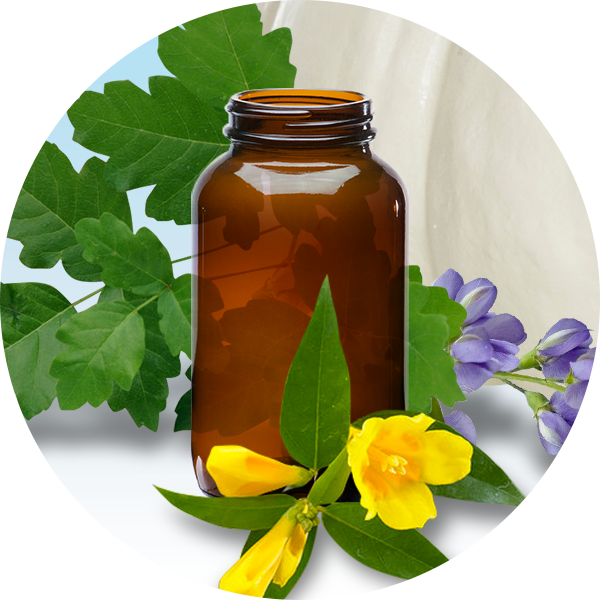This complex is used as a prophylactic and therapeutic agent in influenza epidemics. It can be taken daily throughout the fall-winter season and during actual influenza epidemics. It is recommended to administer the complex more frequently when in contact with people who already have the flu, cough, sneeze or feel exhausted. This homeopathic remedy can also be taken after staying in a crowded room, or after using public transport. In acute conditions, the preparation is taken every 10–15 minutes when awake.

1. Gelsemium sempervirens – yellow jasmine. Say [Gelsemium sempervirens D3, 200C, 10M].
Indications: a typical picture of toxicoinfectious syndrome with fatigue, weakness, muscle aches all over, sweating, fever, nausea, vomiting, headache in the neck, an encephalitic form of the flu after a strong cold with shivering, severe headache with engorgement, fever and stiffness with a sense of numbness, profound unease – the effects of emotional shock.
2. Bryonia аlba – white pumpkin. Say [Brionia аlba D3, 200C, 10M].
Indications: flu-like illness characterized by fever, complete immobilization to stupor with pain in the joints, weakness and fatigue, inability to move, dry mucous membranes, sweating, headache, parching thirst.
3. Eupatorium perfoliatum – bonesets, thoroughworts. Say [Eupatorium perfoliatum D3, 200C, 10M].
Indications: typical toxicoinfectious syndrome with severe bone pain, fever, weakness, severe muscle aches and pains as in broken bones, a painful sensation in the eyeballs, sweating, running nose with sneezes, headache, restlessness.
4. Rhus toxicodendron – poison ivy. Say [Rus toksikodendron D3, 200C, 10M].
Indications: toxico-infectious syndrome affecting the joints, high fever, restlessness, which requires movement, painful stiffness of the joints that also requires movement, dry mucous membranes, red triangle at the end of the furred tongue, sweating, diarrhea, headache, cold sores in the mouth.
5. Phytolacca decandra – poke weed. Say [Fitolaka dekandra D3, 200C, 10M].
Indications: angina-like flu with fever, headache with engorgement, dizziness, muscle aches, sore throat, increase of tonsil size, burning pain on swallowing, inflammation of the cervical lymph nodes.
6. Baptisia tinctoria – wild indigo. Say [Baptisia tinktoria D3, 200C, 10M].
Indications: an intestinal form of the flu with fever, a feeling of pain in the muscles, headache, tightness of the base of the skull, pain in the eyeballs, dry mucous membranes, pain in the abdomen, diarrhea, weakness, dizziness, feeling of increased volume of the head.
7. Belladonna. Say [Beladona D3, 200C, 10M].
Indications: severe viral infection in the initial stage, temperature rising sharply; sore, warm, wet face; sweating; dry mucous membranes; possible delirium, hallucinations due to high temperature; convulsion due to high temperature; elementary rhinitis, anginas, dry cough; intolerance to light, noise, touch and shaking.
8. Aconitum napellus – Sweet William. Say [Akonitum napelus D3, 200C, 10M].
Indications: sudden fever of infectious origin, palpitations, anxiety, nausea, severe cold and emotional stress, cold-neuralgia, accompanied by numbness and tingling of the face.
The neuralgia of the trigeminal nerve is particularly typical.
In these indications, Aconitum practically has no analog in its effect. Administered promptly, it can prevent the chronic paresis of the trigeminal.
9. Nux vomica – strychnine tree. Say [Nuks vomika D3, 200C, 10M].
Indications: flu syndrome with muscle pain, cramping in the lumbar spine, difficulty in movement, typical nose-dry, no flow, especially at night; often the condition is accompanied by a sneeze; these symptoms are relieved by heat, which can even liquefy the congestion mucus; fever that worsens with warmth, and excessive thirst with relief and warming up; headache that feels like a nail has been stuck in one’s crown.
This preparation has a strong preventive effect and works against possible damage of the heart muscle resulting from viral diseases.
10. Carcinosinum – prepared from pathologically altered cells of several types of cancer tissue. Say [Kartsinozinum D3, 200C, 10M].
Indications: common recurrent diseases of the upper respiratory tract and ENT; poor immune response to infectious agents; constantly ill children having little energy.
11. China rubra – cinchona tree. Say [Hina rubra D3, 200C, 10M].
Indications: febrile syndrome with fever that has several stages (coldness in which the patient is wrapping themselves in blankets, then warming up when the patient unwraps themselves, and the sweating stage), weakness, drowsiness.
The complex described here can all be prepared using the universal attenuation “quantum satis potentia” . Find out more on chapter 28.
After saying the name of each preparation, shake the vial vigorously.


